
3.5mm and 1/4 inch jacks remain one of the most used audio jacks in the world. Both jacks are commonly referred to as “headphone jacks,” and they are similar in many regards. But what is the difference between 1/4″ and 3.5mm connectors? That’s what we’ll talk about in this article.
Table of Contents
What is a 3.5mm Connector?
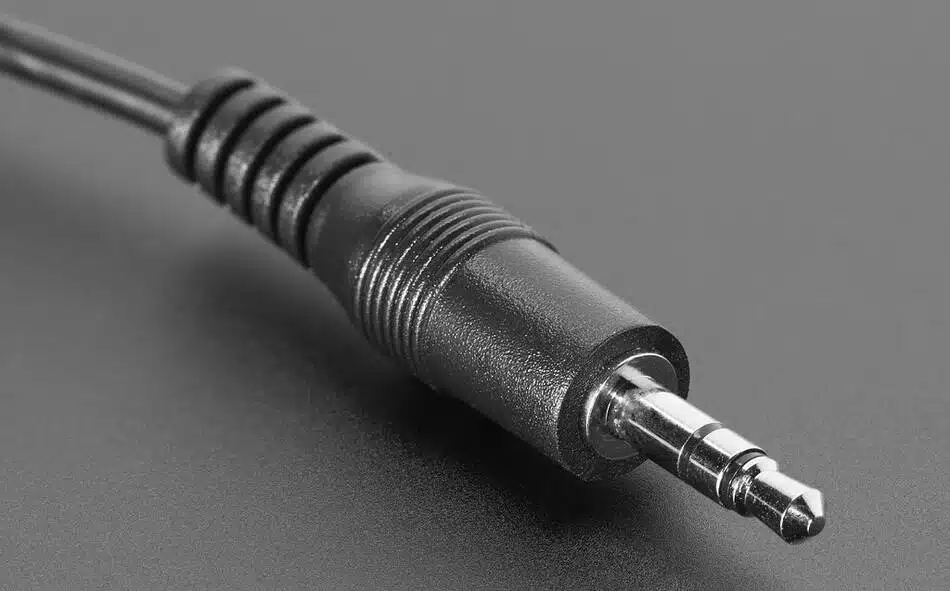
The 3.5mm connector, popularly known as the “headphone-jack,” is common in consumer electronic gadgets. 3.5mm ports are found mostly in portable consumer electronic gadgets such as smartphones, laptops, mp3 players, and the like.
But they are not found only on portable electronics. Many audio interfaces, mixing consoles, DACs, and even some integrated amps have 3.5mm ports on them that allow you to connect your headphones.
Just as I talked about in my article on RCA vs. 3.5mm jacks, there are three types of 3.5mm connectors. And they all work slightly differently. Let’s take a look at them and their differences.
3.5mm TS Male Connector
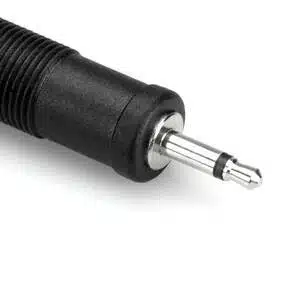
The 3.5mm TS connector is used on two-conductor mono audio cables. These connectors allow you to connect two cables to them. And they can transmit only mono audio signals.
As you can see from the pic above, this connector has two sections, divided by a black. The Tip of the 3.5mm TS connector is known as the Tip. And the bottom is known as the Sleeve. And this is where the acronym “TS” comes from.
The TS in the name stands for Tip and Sleeve. The Tip of the connector transmits the actual audio signal while the Sleeve acts as the ground. This means this connector has only one channel available for transmitting audio signals.
And this is why the 3.5mm TS connector is a monophonic connector.
3.5mm TRS Male Connector
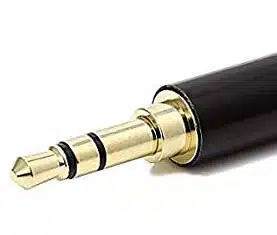
The 3.5mm connector is an upgrade to the TS connector. The 3.5mm TRS male connector is a three-conductor connector that is able to transmit unbalanced stereo signals. They can transmit balanced mono signals as well.
Just as you can see in the image, the 3.5mm TRS male connector is divided into three sections. These three sections are known as the Tip, Ring, and Sleeve. The Tip and the Ring function as the left and right channels of the connector, while the Sleeve serves as the ground.
3.5mm TRRS Male Connector
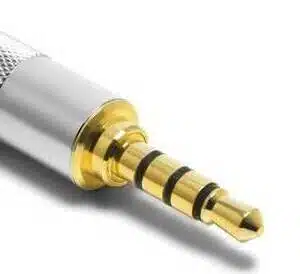
The 3.5mm TRRS male connector is a type of 3.5mm connector that is designed to have four conductors. These four conductors are the Tip, Ring, Ring, and Sleeve. It transmits stereo sound and composite analog videos.
However, this particular connector has been designed mainly to be used with smartphones and computers. This is because it has been incorporated with microphone functionality. What this means is, you can speak through them. Thus, they are used for making headphones that support calls.
What is a 1/4″ Connector?
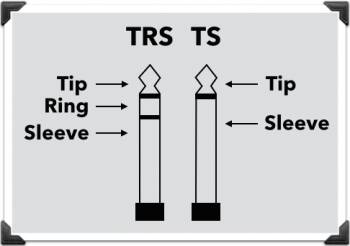
1/4″ (pronounced Quarter-Inch) connector is like the big brother of the 3.5mm connector.
The 1/4 inch connector is a 6.35 mm sized connector. It is one of the commonest audio connectors around. Just as 3.5mm connectors, 1/4 inch connectors are also known as “headphone jack.”
1/4″ ports are found on most professional audio equipment such as audio interfaces, amps, mixers, digital pianos, electric guitars, headphone amplifiers, and even on speakers.
1/4″ connectors are used on professional studio or home devices and are predominantly used in audio production cables. Some of these cables include; instrument cables, microphone cables, and some headphone cables.
Unlike 3.5mm connectors, there are only two types of 1/4″ connectors. Let’s take a look at them.
1/4″ TS Connectors
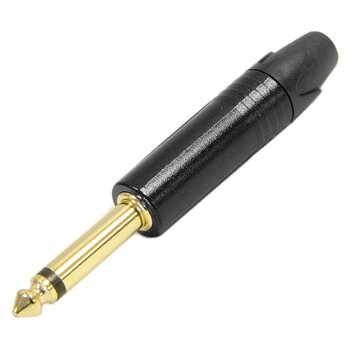
1/4″ TS connectors function the same way as 3.5mm connectors. So everything I said about 3.5mm connectors applies here.
1/4″ TS connectors also have two sections — Tip and Sleeve. And they are made to transmit unbalanced mono audio signals. That’s because it comes with only a single channel for the transmission of audio signals.
1/4″ TRS Connectors
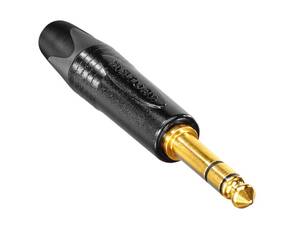
1/4 inch connectors are balanced connectors that have a tip, ring, and Sleeve. The end of the connector is known as the Tip, with the ring being the middle section which has been divided into two plastic rings. This Tip and the ring serve as the left and right channels in the connector. Thus they transmit stereo audio signals. The Sleeve serves as the earth.
Are 3.5mm Connectors and 1/4″ Connectors the Same?
Primarily, both 3.5mm and 1/4 inch connectors are similar in many regards, and they work the same way. But they are different in size. 1/4 inch connectors are bigger in size than 3.5mm connectors
Also, 1/4 inch connectors are longer than 3.5mm connectors. 3.5mm connectors have a length that is between 14-17mm, while 1/4 inch connectors have a length of between 30-31mm. But one thing you should note is that, aside from the difference in size and length, there is not much difference between a 3.5mm connector and a 1/4 inch connector.
Differences between 3.5mm and 1/4″
A 3.5mm and a 1/4 inch connector are two different audio connectors. However, the difference between them is not that significant. Nonetheless, let’s take a look at them.
Size
The difference in size is the most obvious difference between 3.5mm connectors and 1/4 inch connectors. 1/4 inch plugs are longer and huge as well. 1/4 inch connectors have a length of between 30-31mm, while 3.5mm plugs have a length of between 14-17mm.
Just as I mentioned earlier, 1/4 inch connectors have a diameter of 6.35mm. Thus, they are larger than 3.5mm audio connectors. The size of 1/4 inch connectors gives them a large contact surface, which reduces the likelihood of them having bad contact with your equipment. This enables you to have extra stability whenever you are recording.
Durability
When it comes to durability, 1/4 inch connectors are more durable and stable than 3.5mm connectors. This is because 1/4 inch plugs or connectors are large. 3.5mm connectors have a relatively smaller size than 1/4 inch connectors.
The size and length of 1/4 inch connectors make them more rigid. Hence they do not bend or break as easily as 3.5mm connectors. Also, it enables them to withstand damages that usually occur from frequent removal and plugging.
Is A 1/4″ Connector Better Than A 3.5 mm Connector?
In terms of sound quality, there is no noticeable difference between a 1/4″ and 3.5mm connector. Besides that, 1/4″ connectors are better than 3.5mm connectors when it comes to durability and reliability. This is due to the bigger size of 1/4″ connectors compared to 3.5mm connectors.
The durability and stability of 1/4 inch connectors over 3.5mm connectors is the only thing that stands out when comparing the two. When buying an audio cable or audio connector, one of the key attributes to consider is the quality of sound it produces.
However, it is hard to identify an audible difference in quality between 1/4 inch connectors and 3.5mm connectors. In plain terms, the sound quality produced by 3.5mm connectors and 1/4 inch connectors are virtually the same.
Therefore, apart from the durability and stronger connection that a 1/4 inch connector offers, there are no additional attributes that put it ahead of a 3.5mm connector and vice versa.
Benefits of 3.5mm over 1/4″
Cost
3.5mm connectors are small in size. Their build quality is relatively inferior as compared to that of 1/4 inch connectors. Also, the cables that come attached with 3.5mm connectors are quite thin.
These cables have a thin gauge. All of these factors play a role in the final cost of 3.5mm cables. When you compare the cost of 3.5mm cables to 1/4 inch cables, you will realize that 3.5mm cables are cheaper. They cost only a few bucks.
Benefits of 1/4″ over 3.5mm
Standard cable for instruments
Cables that come fitted with 1/4 inch connectors are usually preferred over 3.5mm connector cables. Most musical instruments and audio equipment come with 1/4 inch ports. Some of these musical instruments and audio gear include; mixer boards, bass, guitars, keyboards, combos, and many others.
Since 1/4 inch ports are found on many music equipments, 1/4 inch cables have been accepted as the standard cable of choice for instruments.
Offer Secure Connection
1/4 inch connectors are larger and longer than 3.5mm connectors. Due to their large size and length, they offer a better and secure connection to female ports than 3.5mm connectors do.
This makes them stable as well. Thus, cables that come with 1/4 inch connectors are usually hard to unplug. This means 1/4 inch connectors do not get accidentally disconnected as easily as 3.5mm connectors do.
Durable
As you may already know, 1/4 inch connectors are more durable than 3.5mm connectors. There is no shred of doubt about this. In fact, most sound engineers and musicians I have interacted with have expressed similar sentiments about this.
1/4 inch connectors can withstand more abuse and are not prone to breaking and bending like 3.5mm connectors. Thus, they are able to last longer without getting broken or damaged.
This can be attributed to the high build quality of 1/4 inch connectors. 1/4 inch connectors have a relatively large size and thickness. This is unlike 3.5mm connectors, which have poor build quality.
Easy to Repair and Replace
The ease with which you can repair and replace 1/4 inch connectors when they get damaged is another thing that makes it a better option than 3.5mm connectors. When a 1/4 inch connector gets broken, you can simply replace it with a new one by using a soldering iron. You do not have to buy an entirely new cable.
However, the situation is different for cables that come with 3.5mm connectors. 3.5mm connectors are quite small. The cables they come attached to have a thin gauge. This makes repairing damaged 3.5mm cables difficult.
Therefore, even though damaged 3.5mm connectors can be replaced, it is very difficult to do so. That is why most people simply buy new 3.5mm cables when they get damaged.
Can you connect a ¼” Jack to a 3.5mm port & vice versa?
You can connect a ¼” jack to a 3.5mm audio port. Similarly, you can connect a 3.5mm jack to a ¼” jack. This is possible with the help of a ¼” to 3.5mm adapter.
¼” to 3.5mm adapters are quite common. And they are a very useful tool to have in your arsenal, especially if you’re an audio professional. They can come in handy in times of need. And they are very cheap as well.
You can pick this ¼ inch to 3.5mm adapter on Amazon for about 5 bucks. There is not much to say about this. They get the job done without any issue. I personally own two of these.
Here is another type of ¼” to 3.5mm adapter you might want to consider. Once again, they all work the same way. So choose something that will work for you and your situation.
Conclusion
A 1/4 inch connector is the standard music industry audio connector. The 3.5mm connector can be said to be a mini-sized version of the 1/4 inch connector. 1/4 inch connectors are mainly used for musical instrument cables and some microphone cables.
On the other hand, 3.5mm connectors are ideal for portable consumer audio electronics. Thus, they are meant for gadgets like iPods, CD players, and smartphones.

Hello, I’m Elijah. A writer on Geek Musician, based in Ghana-West Africa. I am a writer with a passion for research and reading. I usually spend my free time playing chess or watching movies. For more info, check out my about me page. Or read more of my articles here.


